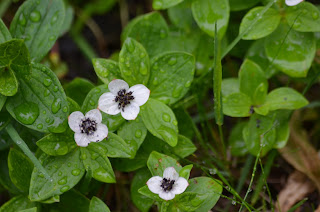 |
| Whale-day by Nicholas Stevenson |
It was late July. The sun had not set since May but we had hardly seen it for a week due to a series of storms that kept us ashore. On this, our last day on the island, it hung red, crackling and fizzing in a shredded sky. The water inside the harbour wall was a mirror, reflecting the sky, the red lighthouse and the old, yellow-painted cod-liver oil factory.
A mink swam out into the shallows and returned with a crab that it ate under the piers of the buildings where the gulls would not steal it from him. Further off, a merganser snorkeled its way across the bay then smashed though it's own reflection and disappeared beneath the water. My watch said it was 1 a.m. It was going to be a whale-day.
My prize for winning a BBC Wildlife story competition was to take part in an Earthwatch expedition of my choice. I chose to watch sperm whales in the Norwegian Arctic, which proved to be quite an adventure; just what I hoped it would be. We were the first six "pathfinder" participants (three Brits and three Americans) on this new project and so we expected there to be a few wrinkles to sort out. The one we encountered was the weather, which is never any-one's fault. We had unusually rough seas most of the time and for two days even the large car-ferries could not sail. Of course this upset our program quite a bit.
Andenes is the flat "ness" or point at the north end of the island of Andøya; 300 miles into the Arctic Circle off the top-left corner of Norway. Neither Google Earth or the maps that bought showed detail of the area around our lighthouse, the Andenes Fyr, because it used to be a Cold War naval base. The water is extremely deep very close to the shore, which is why it was a naval base and why it attracts the male sperm whales that come to fatten up and mature on the locally rich pickings of fish and squid.
This was my first Earthwatch trip but the rest of the team were seasoned volunteers. In fact, Warren Stortroan, who is a Minnesotan of Norwegian descent, has been on 77 Earthwatch trips and Ann Schwendener, from Chicago, isn't far behind. I learned a lot from them, especially the fact that the only thing they need is to feel useful and busy, just like my own volunteers at Paxton Pits. They all shunned the idea of just being tourists, especially on the days we could not get out to survey the whales. I, on the other hand, was grateful for time to photograph plants and look for birds.
Our hosts were the MAREFA scientists who come from all over Europe to study whales. They are inspirational young people, as are their international colleagues who work on the tourist boats. They all know their stuff and effortlessly move between speaking Spanish, Italian, English, German and Norwegian.
 |
| Old whale-ship. No harpoon now, just cameras. |
Whale-days might involve 12 hours of swaying and bucking (not to mention chucking) about in boats, over 20 miles from shore. Your eyes get tired first, then your hips and back from the constant motion. Finally your arms and shoulders ache from holding on to things all day. I found the lighthouse to be even more tiring due to its steep ladders and the high winds on top. We collapsed into bed around midnight each day and the fact that it was often brighter at 1 a.m. than 1 p.m. didn't bother me at all: I could sleep for England.
 |
| Sperm whale. Note the bite from a killer whale. |
Our home at the foot of the lighthouse was an ideal spot from which to explore the Arctic flora and fauna and you might think that, with 24 hours of daylight a day, we would have plenty of time for walking. On whale-days we were kept very busy and on other days the weather was almost too foul to stagger outside without being roped together. All the same, my plant and bird lists grew each day and I had some surprises.
I knew most of the plants from Scotland, where they are considered to be alpines, but at the crest of the beach I met a most peculiar and spectacular assortment of flowers, all existing near the northern edge of their range. It was the same with the land-birds. Old friends like house sparrows and magpies co-existed with bluethroats, redwings, twites and fieldfares.
.jpg) |
| Arctic Tern |
On our last morning-shift we found two new sperm whales to add to the catalogue and then we went out again in the afternoon to find more. Instead we spotted a humpback whale that stayed on the surface for only minutes at a time, and a pod of four killer whales that we followed for over an hour. By the end of the afternoon we were surrounded by over 20 killer whales that came very close to the boat. I will never forget that afternoon.
I would like to thank my Earthwatch colleges for being such brilliant company and the MAREFA project staff for being such attentive hosts.
You can read more about my week in Norway at www.whale-spot.blogspot.com
Jim Stevenson, Paxton Pits Nature Reserve, England.




.jpg)














.jpg)



























